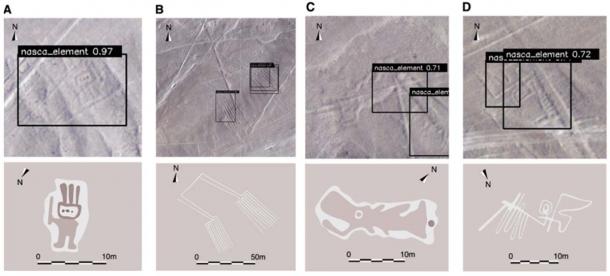
New Nazca Geoglyphs Uncovered in Northern Pampa Using AI Tech
What do a humanoid figure, a bird, a fish, and a pair of legs have in common? Japanese scientists and archaeologists, using a deep artificial intelligence learning model technique, have discovered four previously unnoticed aerial etchings, known as geoglyphs, in the northern part of the famed Nazca Pampa region containing the Nazca Lines in Peru. The humanoid geoglyph depicts a figure holding a club in their right hand, measuring an impressive length of 5 meters (16.4 ft)!
The fish geoglyph has been depicted with a wide-open mouth that measures 19 meters (62.3 ft), and the bird geoglyph measures 17 meters (55.7 ft), while the pair of legs measure 78 meters (256 ft).

AI Deep Learning identified four new Nazca geoglyphs. (A) A humanoid, relief-type. (B) A pair of legs, line-type. (C) A fish, relief-type. (D) A bird, line-type. The study reveals these finds to the public for the first time. (Science Direct)
AI Deep Learning in the Nazca Geoglyphs
The new study conducted by Japanese scientists from the Yamagata University, has been published in the Journal of Archaeological Science. By utilizing AI deep learning (DL) techniques in their research, the team from Yamagata University has made significant strides in uncovering new geoglyphs within the Nazca Pampa. They’ve also added to the richly growing body of the harmonious use of technology and archaeology.
“We have developed a DL [deep learning] pipeline that addresses the challenges that frequently arise in the task of archaeological image object detection,” the study’s authors write.
“Our method enables the discovery of previously unattainable targets by enabling DL to learn representations of images with better generalization and performance. Additionally, by speeding up the research process, our approach advances archaeology by introducing a novel paradigm that combines field research and AI, resulting in more effective and efficient investigations.”
Since 2004, Yamagata University has been conducting extensive surveys of geoglyph distribution in the Nazca Pampa, covering a vast area spanning over 390 km2, reports Arkeonews. These surveys have utilized advanced technologies, including satellite imagery, aerial photography, airborne scanning LiDAR, and drone photography, to comprehensively investigate the area.
In 2016, the research team employed aerial photography with a ground resolution of 0.1 meters (0.32 ft) per pixel to conduct a detailed survey of the region. Over time, they successfully identified numerous geoglyphs. However, the traditional process of identification proved to be exceedingly time-consuming. To overcome this challenge, the researchers turned to AI deep learning techniques, allowing them to analyze the photographs at a significantly faster rate.
The latest has been the liberal use of AI 2018 onwards, reports Mainchi Japan. For this, they write that, “…by using deep learning technology, it is now possible to identify potential ground paintings about 21 times faster than looking for ground paintings from aerial photography with the naked eye,” as per a press release.
- Dozens of Large, Mysterious Rings and Rock Piles Identified in Peru
- New Study suggests Nazca Lines formed Ancient Pilgrimage Route to Cahuachi Temple
The Nazca Geoglyphs: Rich in History
The Nazca Pampa's geoglyphs were initially identified during the 1920s, and ongoing studies since the 1940s have revealed a wide array of figurative designs, encompassing zoomorphic depictions, geometric shapes, and linear patterns.

Geoglyphs can be classified into three main types: figurative, geometric, and lineal. (A) “Line-type figurative geoglyphs” were made by removing black stones in a linear pattern exposing the white sand underneath. (B to E) “Relief-type figurative geoglyphs” are often located on slopes and comprise a combination of black stone and white sand surfaces. (Yamagata University Institute of Nasca)
Geoglyphs in the Nazca Pampa can be broadly categorized into three main types: figurative, geometric, and linear. Archaeologists theorize that the linear geoglyphs were crafted by the Nazca people, a culture that thrived during the Early Intermediate Period. This civilization is generally divided into distinct phases, including the Proto Nazca (Phase 1, 100 BC to AD 1), Early Nazca (Phases 2–4, AD 1 to 450), Middle Nazca (Phase 5, AD 450 to 550), and Late Nazca (Phases 6–7, AD 550 to 750), reports Heritage Daily.
The geoglyphs' iconography suggests a Late Formative period origin (400 to 200 BC) due to their resemblance to the iconography found on Formative petroglyphs discovered on rock outcrops. During this era, the Paracas Culture, an Andean civilization that emerged around 800 BC and lasted until 100 BC, inhabited the region.
- Ten of the Biggest and Best Geoglyphs from the Ancient World
- High winds expose previously unknown Nazca geoglyphs
In the current study, a breakthrough was achieved through the development of an innovative approach to label training data, effectively identifying similar partial patterns between the known and new geoglyphs. Similar breakthroughs are likely to be made in the field of archaeology and data science in the coming years.
Masato Sakai, professor of cultural anthropology and Andean archaeology at the university, said, "We found that AI can do in one year what it would take more than 20 years by human power alone. This will further accelerate the study of geoglyphs."
Top image: Left, Nazca geoglyphs recently discovered using artificial intelligence show figures of a pair of bird legs, a humanoid and a fish at Nazca in Peru. Right, Examples of various types of Nazca image creation techniques. Source: Yamagata University Institute of Nasca
By Sahir Pandey
References
Kayra, O. 2023. Scientists discover 4 new Nazca Geoglyphs using AI deep learning. Available at: https://arkeonews.net/scientists-discover-4-new-nazca-geoglyphs-using-ai-deep-learning/.
Mainichi, Japan. 2023 Japan university, IBM discover 4 additional Nazca Lines figures using AI. Available at: https://mainichi.jp/english/articles/20230602/p2a/00m/0sc/034000c
Milligan, M. 2023. NAZCA GEOGLYPHS DISCOVERED USED AI DEEP LEARNING. Available at: https://www.heritagedaily.com/2023/06/nazca-geoglyphs-discovered-used-ai-deep-learning/147532.
Sakai, M., et al. 2023. Accelerating the discovery of new Nazca geoglyphs using deep learning. Journal of Archaeological Science. Available at: https://doi.org/10.1016/j.jas.2023.105777.















